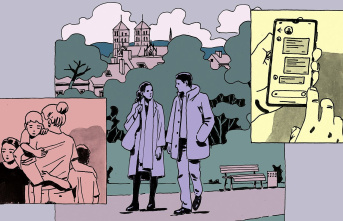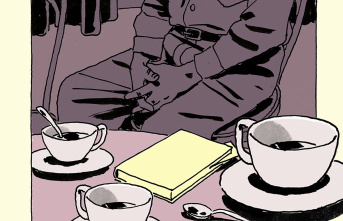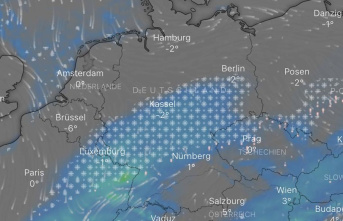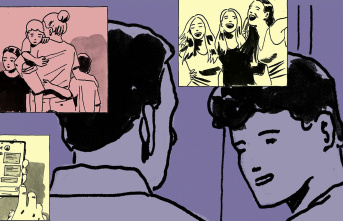With the Werwolf organization, the leadership of the Third Reich wanted to conduct a kind of partisan warfare. It was founded in September 1944 by Heinrich Himmler, who was aware even then that the Allies would soon occupy German territory. Trained squads, supplied from secret depots, were supposed to spread fear and terror behind enemy lines.
The soldiers were trained, at least pro forma, by Otto Skorzeny, the most famous commando soldier in the Reich. The whole operation was of no military importance, there were hardly any volunteer soldiers. And hardly anyone was willing to carry out the orders later in Allied-occupied territory. But the Nazi leadership still found volunteers: fanatical young people.
The organization was built pompously and hierarchically, there was even a "Reichs-werewolf". After the war, Allied experts were amazed at how little the Germans had learned from the partisan war. Another point was that the preparation of the Reich for the so-called final battle served many to avoid a real frontline action at the last minute. So it happened that particularly war-weary men got involved in these fanatical projects. The werewolves could neither prevent the defeat of Nazi Germany nor the establishment of a new administration. Only occasionally did they carry out acts of terrorism.
One of the most famous was the assassination attempt on Aachen Mayor Franz Oppenhoff. The city had a high symbolic value because of its special position in the Middle Ages. In October 1944, it was the first German city to be attacked and fiercely defended by US troops. The tough fight came as a shock to the Americans, and the days of rapid advances after breaking out of the Normandy bridgehead were over.
The city was conquered on October 21, and the US armed forces won Franz Oppenhoff as mayor – the lawyer had defended opponents of the regime in the Third Reich. When Hitler got this news, he is said to have thrown a tantrum and personally ordered Oppenhoff's murder. Himmler then planned a use in the style of the later James Bond films. The expense of the operation was disproportionate to assassinating an official that the Allies could easily replace.
Adolf Prützmann, a war criminal and general of the Waffen-SS, was put in charge of Operation Carnival. The actual squad was led by SS-Untersturmfuhrer Herbert Wenzel, his deputy was SS-Unterscharfuhrer Joseph Leitgeb. Leitgeb was a battle-hardened front-line soldier who was said to have unconditional bravery.
In order to bring the two to Aachen, two men were assigned as local guides, Georg Heidorn and Karl-Heinz Hennemann. A young woman and a Hitler Youth formed the conclusion. Before the war, 22-year-old Ilse Hirsch lived in Aachen. She was supposed to be in command in Aachen, and it was also hoped that the Allied military police would not control a young woman so strictly. Ilse Hirsch was a member of the Bund Deutscher Mädel and was often shown off because of her Aryan appearance. The only 16-year-old Hitler youth, Erich Morgenschweiss, was also selected as an inconspicuous spy.
Because of the complicated plan, it took until the end of March 1945 to complete all the preparations. The commando was to be brought near the city in a US B-17 Flying Fortress bomber captured by the Nazis and parachuted into Belgian territory. On March 20, the B-17 took off at 9:00 p.m. from Hildesheim Airport, and the jump took place at midnight. But the small group was spotted by border guard Joseph Saive and his girlfriend. The SS men shot the Dutchman, but the girl escaped. The Allies were thus informed of the small unit's arrival, but they knew nothing of the objectives of the operation.
When landing at night, Ilse Hirsch was separated from the rest of the group. That was no reason for her to give up, she set out on her own. On the morning of March 21, she alone entered the desert of ruins that had once been Aachen. Hirsch scouted the town and target without arousing suspicion. With a basket, she disguised herself as a helpless woman looking for something to eat, a common sight at the time that didn't really attract attention. On March 22, the rest of the commando reached the city limits but remained in the forest outside the city. On March 23, Hirsch happened to meet two of the men in front of the Aachen employment office.
On the evening of the 25th, part of the group set out to kill Franz Oppenhoff. He and his wife Irmgard had put the children to bed before leaving to meet friends at a neighboring house. The killers knew nothing about the date. At 9 p.m. they broke into the house through a basement window, but did not find the Oppenhoffs. So they improvised: They told the housekeeper that they were shot down by German planes and urgently needed papers from the mayor. Oppenhoff fetched the unsuspecting woman.
The leader of the group, Herbert Wenzel, was to commit the murder. But at the crucial moment he lost his nerve and stood there trembling. Leitgeb took the Walther pistol from him and shouted "Heil Hitler!" and shot Oppenhoff in the head. The whole group was then able to escape undetected. Radio Werwolf went on the air on April 1st. The assassination was celebrated here and all Nazis in the occupied zones were asked to follow suit. In fact, there has not been another assassination attempt on a mayor.
From the camp in the forest, Leitgeb wanted to lead Ilse Hirsch, the young Morgenschweiss and Heidorn to the German lines. He had lost contact with other members in Aachen.
On the morning of the 27th, Leitgeb set off a mine in a meadow near Rollesbroich, killing him instantly. In the afternoon, Ilse Hirsch stumbled over a wire with a booby trap on the outskirts of Schleiden. Her right leg was badly injured. Morgenschweiss and Heidorn also suffered injuries but were able to continue the march, leaving Ilse Hirsch behind. The next morning she was found by a farmer's wife.
The next morning the young morning sweat could not continue and stayed behind. By sheer coincidence, Heidorn met the rest of the group. Heidorn and Hennemann still crossed the Rhine, but were arrested by a US patrol. Their importance was not recognized. They were imprisoned as ordinary prisoners of war. SS-Untersturmfuhrer Wenzel had previously separated from the others and was never seen again. In the 1990s, historian Hannes Heer assumed he had tracked down Wenzel, according to which he lived in present-day Namibia under the name Fritz Brandt and died in 1981.
SS General Prützmann killed himself with a poison capsule. In autumn 1949, Heidorn, Hennemann and Hirsch were tried in Aachen. The young morning sweat was not charged and appeared as a witness.
Ilse Hirsch was acquitted because she was not present at the actual murder. Hennemann got 18 months, Heidorn only one year. The penalties were ridiculously light. Crucial to the judiciary of the time, the two had no authority - all the commanding officers had been killed. And none of the defendants had fired the fatal shot.
Ilse Hirsch continued to live in the Aachen area and had two children. She did not appear politically again and died in 2000.












